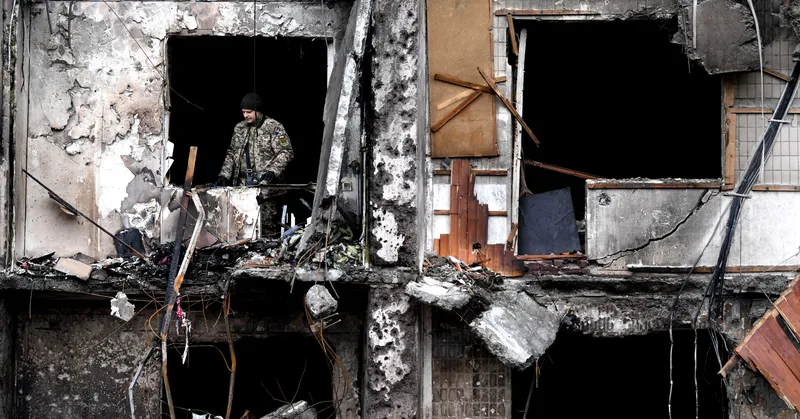
Footage from Russia’s attack on Ukraine leaves no doubt about Valdimir Putin’s willingness to ravage an entire people in pursuit of his goals. However, reports of one weapon in particular has struck fear into even the most hardened military and explosives experts: cluster bombs.
The history and use of these weapons are even darker than those of the average explosive, and these instruments of death might render Ukraine a battlefield for decades to come. The earliest reports of Russia using cluster munitions in Ukraine detail bombs hitting a hospital and an apparent civilian residence in Ukraine – attacks suggestive of the unique purpose of cluster bombs: forcing war into all corners of a country, including those deemed off-limits.
The term “cluster munitions” encompasses a broad catalogue of weapons so named because each bomb is a blackberry-like cluster of many smaller “bomblets.” One cluster bomb might contain anywhere from a scant handful to hundreds of bomblets.
These clusters break apart in mid-flight to fall where they may, like the wind-scattered seeds of an autumn dandelion. Lacking tracking systems or precision targeting capabilities, the bomblets are indiscriminate in not only what or who they hit but when.
Bomblets that fail to detonate may lie dormant for decades, poised for the unfortunate jostle that sets them off. As such, cluster bombs inflict a “salt the earth” approach to war, a method of sowing destruction so complete and thorough that they render the land too dangerous to reinhabit. This is also partly why they mostly kill civilians and bystanders, not combatants.
And, contrary to the commentary by American politicians and news anchors over the past few weeks, Russia shocked is not alone in its deployment of these weapons. The United States of America uses cluster bombs too.
The cluster bomb may not have been invented by the Nazis, but they certainly perfected it. In 1940, invading Nazi troops discovered a secret cache of unused bomblets stashed somewhere in occupied France. This new concept of weaponry appealed to Luftwaffe munitions designer General Ernst Marquard, who soon created the SD-2, also known as the “Butterfly bomb.” He unleashed it on the world less than four months later.
SD-2 bomblets were tin-can-sized steel cylinders containing a thoroughly deadly 7.5 ounces of TNT, and military historian Jeffrey Leatherwood refers to the little droplets of death as the product of Marquard’s “twisted genius.”
In Leatherwood’s 2012 book about the history of explosive ordnance disposal, Nine from Aberdeen, he calls them, without hesitation, “Germany’s most dangerous bomb of the war.”
Marquard’s Butterfly bomb remains one of the most infamous weapons in history, but not necessarily for the death and destruction they caused during World War II.
The most alarming danger posed by the Butterfly – and by modern cluster bombs, which can echo the SD-2’s basic design – is that they don’t always go off right away. They also look innocuous, even toylike, and can be difficult to detect, a combination that makes them even more deadly.
Cluster bomblets’ terrifying similarity to toys has killed children across generations. The German Butterfly bombs were sometimes even painted in vibrant reds and yellows, augmenting the similarity. After their release, each Butterfly would spread out its four wide wings, which made the little devices spin like helicopter seed pods fluttering to the ground. (In the case of the Butterfly bomb, the spinning is what made the bomblets arm themselves.)
Even with more modern cluster bombs, if the original trigger does not work properly, a slight jostle is likely to set them off. Studies of cluster bomblets used in Iraq, Kuwait, Lebanon, and Afghanistan have found that between one-quarter and two-thirds of the victims of the bombs were children, who were usually killed while playing.
During World War II, German bombers dropped 6,700 tons of bombs on Malta, a tiny island in the Mediterranean, over 154 straight days and nights of hell—the longest bombardment in history. In 2009, nearly 70 years after the Siege of Malta, Andrew Worley would arguably become the youngest living survivor of that attack.
Worley, then age 11, was hunting for suitable airsoft targets while on a family camping trip. He says he was “rummaging through the rubble walls looking for cans” to shoot, when he picked up a strange rusty cylinder. He assumed it was a car’s oil filter, and he started “looking at it” and “shaking it around,” then carried it back to the campsite. His father, luckily, saw the German words etched onto the circular fuse and, being an avid history buff, immediately took it away from his young son.
The canister turned out to be the TNT-filled central core of an old Butterfly. More than a half-century after it first fell, the bomblet was still intact, sitting among the rubble, waiting to be picked up by an intrepid young child. The Army of Malta’s bomb disposal personnel considered the find too dangerous to move further, so rather than try to defuse it, they detonated it in place.
A graphic designer and illustrator now in his twenties, Worley was one of the lucky children to escape a bleak cluster bomb fate. And while the bombings occurred long before Worley’s birth, he talks about their present-day consequences without concern or a sense of abnormality, as if dealing with the effects of that dark history is a natural and even daily fact of Maltese life.
Stories like Worley’s are woefully common. One popular podcast, My Favorite Murder, even recently aired an episode where the hosts read a letter from an adult listener who, as a child, had thrown rocks at and picked up an unexploded piece of a bomblet-sized explosive from a beach out of concern for the safety of “the beloved sea creatures.”
Historically, 98 per cent of cluster bomb victims are civilians, because of the way the munitions are peppered into an area before – or sometimes even without – sending in troops, according to a 2011 study by foreign policy and terrorism expert Beau Grosscup. It was a tactic the Nazis would use to clear land they wanted, and ironically, they used it heavily against Russia.
After one so-called “saturation raid” unleashed over a Russian forest, as Leatherwood detailed in his book on the subject, a German general said, “German ground forces could enter … without encountering any resistance – the forest was truly dead.”
Russia’s modern PTAB-1M bomblets, shown in one recent video of Ukrainian forces collecting them by the hundreds, have evolved since the days of the SD-2 to be able to penetrate tanks, and they can impact areas hundreds of meters in radius. However, both old and modern bomblets can fail to explode.
Calculated percentages of cluster bomb duds vary between 5 and 40 per cent, which when multiplied by the massive total numbers of cluster bombs typically released to create the “saturation” effect, provides a terrifying amount of ordnance left behind.
Of the 1,818 American bomblets that the US acknowledges it sprayed over the Shomali Valley in Afghanistan in the fall of 2001, 17.4 percent failed to explode, leaving over 300 deadly weapons lying in wait in that valley alone, according to a 2003 study published in Military Medicine.
About a third of those were embedded under the soil, meaning they were impossible to see and could easily be set off by the foot of an innocent pedestrian. By 2003, at least three children had already been injured because they thought American bomblets found in the Shomali Valley were toys.
The danger they pose to civilians, and children in particular, are why cluster bombs are considered one of the darkest, most menacing tools of warfare. Use of cluster bombs is no less than an acknowledgement that the war is being waged upon civilians, deliberately and willfully. They are a weapon of terror. Some military scholars have argued that even napalm is a more humane alternative.
Pentagon documents released by WikiLeaks in October 2010 suggested that over 8,000 cases of unexploded American cluster munitions were known to occur in Iraq alone. In 2008, the United Nations put forth a treaty to eliminate cluster munitions, and 110 parties signed it, vowing to eliminate the weapons from their arsenal.
Neither Ukraine nor Russia signed, but many of the countries that have experienced the horrors of cluster munitions on their soil, including Iraq, Lebanon, Germany, the United Kingdom, and Malta, did commit to the agreement.
The United States notably did not sign, though it did institute a policy to reduce the rate of dud bomblets to less than 1 percent—a policy it reversed in 2017. The history of cluster munitions, and how they kill civilians, demands we question why any country would use them in their current, unreliable format. Not just Russia.
- A Wired report











